西安电子科技大学:《计算机通信与网络》课程教学课件(讲稿)第三部分 数据链路层 第16章 无线WAN——移动电话和卫星网络 Cellular Telephone and Satellite Networks

Data Communications and Networking Forouzan Fourth Edition Chapter 16 Wireless WANs: Cellular Telephone and Satellite Networks 16.1 CopyrightThe McGraw-Hill Companies,Inc.Permission required for reproduction or display
16.1 Chapter 16 Wireless WANs: Cellular Telephone and Satellite Networks Copyright © The McGraw-Hill Companies, Inc. Permission required for reproduction or display
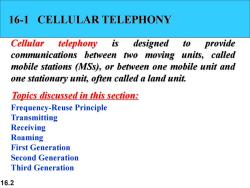
16-1 CELLULAR TELEPHONY Cellular telephony is designed to provide communications between two moving units,called mobile stations (MSs),or between one mobile unit and one stationary unit,often called a land unit. Topics discussed in this section: Frequency-Reuse Principle Transmitting Receiving Roaming First Generation Second Generation Third Generation 16.2
16.2 16-1 CELLULAR TELEPHONY Cellular telephony is designed to provide communications between two moving units, called mobile stations (MSs), or between one mobile unit and one stationary unit, often called a land unit. Frequency-Reuse Principle Transmitting Receiving Roaming First Generation Second Generation Third Generation Topics discussed in this section:
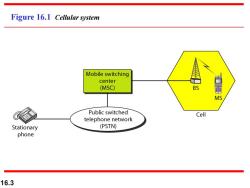
Figure 16.1 Cellular system Mobile switching center (MSC) BS MS Public switched Cell telephone network Stationary (PSTN) phone 16.3
16.3 Figure 16.1 Cellular system
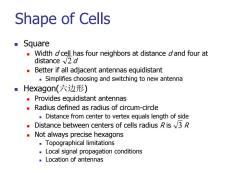
Shape of Cells Square Width dcellhas four neighbors at distance dand four at distance√2d Better if all adjacent antennas equidistant Simplifies choosing and switching to new antenna ■Hexagon(六边形) Provides equidistant antennas Radius defined as radius of circum-circle Distance from center to vertex equals length of side Distance between centers of cells radius R is 3 R Not always precise hexagons Topographical limitations Local signal propagation conditions ■Location of antennas
Shape of Cells Square Width d cell has four neighbors at distance d and four at distance d Better if all adjacent antennas equidistant Simplifies choosing and switching to new antenna Hexagon(六边形) Provides equidistant antennas Radius defined as radius of circum-circle Distance from center to vertex equals length of side Distance between centers of cells radius R is R Not always precise hexagons Topographical limitations Local signal propagation conditions Location of antennas 2 3
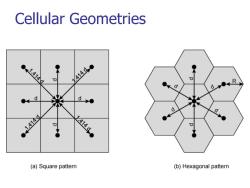
Cellular Geometries 414④d 414 (a)Square pattern (b)Hexagonal pattern
Cellular Geometries

Figure 16.2 Frequency reuse patterns a.Reuse factor of 4 b.Reuse factor of 7 16.6
16.6 Figure 16.2 Frequency reuse patterns
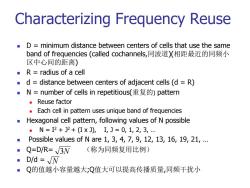
Characterizing Frequency Reuse D minimum distance between centers of cells that use the same band of frequencies(called cochannels,.同波道)(相距最近的同频小 区中心间的距离) ■R=radius of a cel d distance between centers of adjacent cells(d R) ■N=number of cells in repetitioust(重复的)pattern ·Reuse factor Each cell in pattern uses unique band of frequencies Hexagonal cell pattern,following values of N possible ·N=2+J2+(1×J),I,J=0,1,2,3,. Possible values of N are 1,3,4,7,9,12,13,16,19,21,. ■Q=D/R=√3N (称为同频复用比例) ■ D/d =N Q的值越小容量越大;Q值大可以提高传播质量,同频干扰小
Characterizing Frequency Reuse D = minimum distance between centers of cells that use the same band of frequencies (called cochannels,同波道)(相距最近的同频小 区中心间的距离) R = radius of a cell d = distance between centers of adjacent cells (d = R) N = number of cells in repetitious(重复的) pattern Reuse factor Each cell in pattern uses unique band of frequencies Hexagonal cell pattern, following values of N possible N = I2 + J2 + (I x J), I, J = 0, 1, 2, 3, . Possible values of N are 1, 3, 4, 7, 9, 12, 13, 16, 19, 21, . Q=D/R= (称为同频复用比例) D/d = Q的值越小容量越大;Q值大可以提高传播质量,同频干扰小 3N N
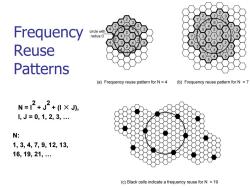
Frequency circle with radius D Reuse Patterns (a)Frequency reuse pattern for N=4 (b)Frequency reuse pattern for N =7 N=2+J2+0×, 1,J=0,1,2,3,. N: 1,3,4,7,9,12,13, 16,19,21, (c)Black cells indicate a frequency reuse for N =19
Frequency Reuse Patterns N = I2 + J2 + (I × J), I, J = 0, 1, 2, 3, . N: 1, 3, 4, 7, 9, 12, 13, 16, 19, 21,
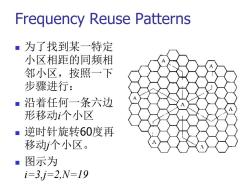
Frequency Reuse Patterns ■为了找到某一特定 小区相距的同频相 邻小区,按照一下 步骤进行: ■沿着任何一条六边 A 形移动个小区 ■逆时针旋转60度再 移动个小区。 ■图示为 i=3,j=2,N=19
Frequency Reuse Patterns 为了找到某一特定 小区相距的同频相 邻小区,按照一下 步骤进行: 沿着任何一条六边 形移动i个小区 逆时针旋转60度再 移动j个小区。 图示为 i=3,j=2,N=19
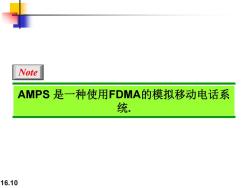
Note AMPS是一种使用FDMA的模拟移动电话系 统 16.10
16.10 AMPS 是一种使用FDMA的模拟移动电话系 统. Note
按次数下载不扣除下载券;
注册用户24小时内重复下载只扣除一次;
顺序:VIP每日次数-->可用次数-->下载券;
- 西安电子科技大学:《计算机通信与网络》课程教学课件(讲稿)第三部分 数据链路层 第15章 连接局域网、主干网和虚拟局域网 Connecting LANs, Backbone Networks, and Virtual LANs.pdf
- 西安电子科技大学:《计算机通信与网络》课程教学课件(讲稿)第三部分 数据链路层 第14章 无线局域网.pdf
- 西安电子科技大学:《计算机通信与网络》课程教学课件(讲稿)第三部分 数据链路层 第13章 有线局域网——以太网.pdf
- 西安电子科技大学:《计算机通信与网络》课程教学课件(讲稿)第三部分 数据链路层 第12章 多路访问 Multiple Access.pdf
- 西安电子科技大学:《计算机通信与网络》课程教学课件(讲稿)第三部分 数据链路层 第11章 数据链路控制 Data Link Control.pdf
- 西安电子科技大学:《计算机通信与网络》课程教学课件(讲稿)第三部分 数据链路层 第10章 检错与纠错 Error Detection and Correction.pdf
- 西安电子科技大学:《计算机通信与网络》课程教学课件(讲稿)第二部分 第9章 使用电话网和有线电视网进行数据传输.pdf
- 西安电子科技大学:《计算机通信与网络》课程教学课件(讲稿)第二部分 第8章 交换.pdf
- 西安电子科技大学:《计算机通信与网络》课程教学课件(讲稿)第二部分 第7章 传输介质.pdf
- 西安电子科技大学:《计算机通信与网络》课程教学课件(讲稿)第二部分 第6章 带宽利用 Bandwidth Utilization:Multiplexing and Spreading.pdf
- 西安电子科技大学:《计算机通信与网络》课程教学课件(讲稿)第二部分 第5章 模拟传输 Analog Transmission.pdf
- 西安电子科技大学:《计算机通信与网络》课程教学课件(讲稿)第二部分 第4章 数字传输 Digital Transmission.pdf
- 西安电子科技大学:《计算机通信与网络》课程教学课件(讲稿)第二部分 物理层和介质 第3章 物理层——数据和信号.pdf
- 西安电子科技大学:《计算机通信与网络》课程教学课件(讲稿)第一部分 概述 第2章 网络模型.pdf
- 西安电子科技大学:《计算机通信与网络》课程教学课件(讲稿)第一部分 概述 第1章 绪论(主讲:权义宁).pdf
- 西安电子科技大学:《数字信号处理》课程教学课件(讲稿)09 多采样率数字信号处理.pdf
- 西安电子科技大学:《数字信号处理》课程教学课件(讲稿)08 时域离散系统的实现.pdf
- 西安电子科技大学:《数字信号处理》课程教学课件(讲稿)07 FIR数字滤波器(FIRDF)设计.pdf
- 西安电子科技大学:《数字信号处理》课程教学课件(讲稿)06 IIR数字滤波器(IIRDF)设计.pdf
- 西安电子科技大学:《数字信号处理》课程教学课件(讲稿)05 数字滤波器的基本概念及一些特殊滤波器.pdf
- 西安电子科技大学:《计算机通信与网络》课程教学课件(讲稿)第三部分 数据链路层 第17章 广域网SONET、SDH.pdf
- 西安电子科技大学:《计算机通信与网络》课程教学课件(讲稿)第三部分 数据链路层 第18章 虚电路网络——帧中继和ATM.pdf
- 西安电子科技大学:《计算机通信与网络》课程教学课件(讲稿)第四部分 网络层 第19章 逻辑寻址.pdf
- 西安电子科技大学:《计算机通信与网络》课程教学课件(讲稿)第四部分 网络层 第20章 IP协议.pdf
- 西安电子科技大学:《计算机通信与网络》课程教学课件(讲稿)第四部分 网络层 第21章 地址映射、差错报告和多播.pdf
- 西安电子科技大学:《计算机通信与网络》课程教学课件(讲稿)第四部分 网络层 第22章 传递、转发和路由选择.pdf
- 西安电子科技大学:《计算机通信与网络》课程教学课件(讲稿)第五部分 传输层 第23章 UDP、TCP和SCTP.pdf
- 西安电子科技大学:《计算机通信与网络》课程教学课件(讲稿)第五部分 传输层 第24章 拥塞控制和服务质量.pdf
- 西安电子科技大学:《计算机通信与网络》课程教学课件(讲稿)第六部分 传输层 第25章 域名系统 Domain Name System.pdf
- 西安电子科技大学:《计算机通信与网络》课程教学课件(讲稿)第六部分 传输层 第26章 远程登录、电子邮件和文件传输 Remote Logging, Electronic Mail, and File Transfer.pdf
- 西安电子科技大学:《计算机通信与网络》课程教学课件(讲稿)第六部分 传输层 第27章 万维网与超文本传输协议 WWW and HTTP.pdf
- 西安电子科技大学:《电路分析基础》课程教学资源(PPT课件)知识点串讲(主讲教师:杨龙).pptx
- 西安电子科技大学:《电路分析基础》课程教学资源(PPT课件)绪论、第一章 电路的基本定律(1/2).pptx
- 西安电子科技大学:《电路分析基础》课程教学资源(PPT课件)总复习课件(共六章,主讲:杨龙).pdf
- 西安电子科技大学:《电路分析基础》课程教学资源(PPT课件)第一章 电路的基本定律(2/2)、第二章 电阻电路分析(1/5).pptx
- 西安电子科技大学:《电路分析基础》课程教学资源(PPT课件)第二章 电阻电路分析(3/5).pptx
- 西安电子科技大学:《电路分析基础》课程教学资源(PPT课件)第二章 电阻电路分析(2/5).pptx
- 西安电子科技大学:《电路分析基础》课程教学资源(PPT课件)第二章 电阻电路分析(5/5).pptx
- 西安电子科技大学:《电路分析基础》课程教学资源(PPT课件)第二章 电阻电路分析(4/5).pptx
- 西安电子科技大学:《电路分析基础》课程教学资源(PPT课件)第三章 动态电路(1/4)3.1 动态元件.pptx
